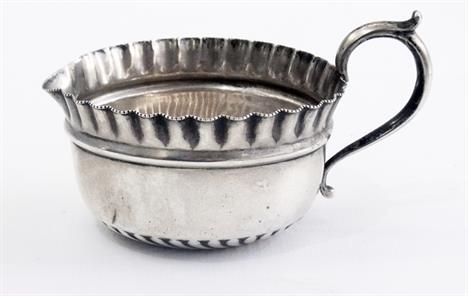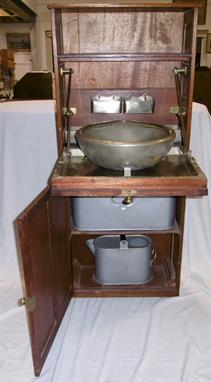COOTE,. Michael; The Lost World (Arthur Conan Doyle ) inspired pastel study of a T-Rex dinosaur. Large. Framed and glazed. The Lost World is a novel released in 1912 by Sir Arthur Conan Doyle concerning an expedition to a plateau in the Amazon basin of South America where prehistoric animals (dinosaurs and other extinct creatures) still survive. It was originally published serially in the popular Strand Magazine and illustrated by New-Zealand-born artist Harry Rountree during the months of April-November 1912. The character of Professor Challenger was introduced in this book. The novel also describes a war between indigenous people and a vicious tribe of ape-like creatures. Michael Coote studied as a photo lithographer, and is often credited as 'colour illustrator' on contemporary Sherlock Holmes publications.
We found 23407 price guide item(s) matching your search
There are 23407 lots that match your search criteria. Subscribe now to get instant access to the full price guide service.
Click here to subscribe- List
- Grid
-
23407 item(s)/page
COOTE, MICHAEL; The Lost World ( Arthur Conan Doyle ) large oil on canvas painting of Professor Challenger and party approaching rock face. Framed. Unsigned. 77cm x 100cm. The Lost World is a novel released in 1912 by Sir Arthur Conan Doyle concerning an expedition to a plateau in the Amazon basin of South America where prehistoric animals (dinosaurs and other extinct creatures) still survive. It was originally published serially in the popular Strand Magazine and illustrated by New-Zealand-born artist Harry Rountree during the months of April-November 1912. The character of Professor Challenger was introduced in this book. The novel also describes a war between indigenous people and a vicious tribe of ape-like creatures. Michael Coote studied as a photo lithographer, and is often credited as 'colour illustrator' on contemporary Sherlock Holmes publications.
PERSIA, Alexandrine Empire. Mazakes. Satrap of Mesopotamia, 331-323/2 BC. AR Tetradrachm (24.5mm, 17.40 g, 9h). Helmeted head of Athena right / Owl standing right, head facing; olive spray and crescent to left, small T-like symbol and MZDK (in Aramaic) to right. Le Rider, Alexander, pp. 214-9; Van Alfen, Owls, Group IVc, 95 = O. Mørkholm, “A Coin of Artaxerxes III” in NC 1974, pl. I, 6 (same dies). VF, toned. Well centered on a broad flan. Very rare. Mazakes is best known as the Persian satrap who took over Egypt after Sabakes fell in battle against Alexander the Great`s army at the Granicus, and later handed over the province peacefully to the Macedonian king. Imitative owls in the name of Mazakes have been known for some time, and all were originally attributed to his satrapy in Egypt. However, it was clear that stylistic elements separated the coinage into two general groups. More recent hoards, especially the 1973 Iraq hoard, have shown that one of the groups of imitative owls was certainly not struck in Egypt, but somewhere in the territory of modern day Iraq. In his analysis of the 1973 hoard, M. Price ("Circulation at Babylon in 323 B.C." in W.E. Metcalf, ed., Mnemata: Papers in Memory of Nancy M. Waggoner [New York, 1991], pp. 63–72) changed the findspot from Iraq to the more specific cite of Babylon, based on anecdotal evidence (p. 63), and gave the series of Mazakes` owls to the city. However, such an assignment has forced numismatists to conduct mental gymnastics in order to rationalize the presence of Mazakes` coins at Babylon (cf. Van Alfen, Owls, pp. 27–33, and Le Rider, Alexander, pp. 215–7, for a summary of the previous research).It is clear that the attribution of the owls to Babylon is almost certainly incorrect, and other find evidence suggests an attribution to somewhere further north, perhaps in the satrapy of Mesopotamia (cf. Le Rider, op. cit., p. 217–9). In any event, this coinage clarifies the historical record regarding the disposition of Mazakes following his hand-over of Egypt, upon which subject the literary evidence is silent. As noted by Le Rider (op. cit., p. 215), one can compare Mazakes to other Persians who peacefully welcomed Alexander to their domains: Mazaios, who handed over Cilicia, was later made satrap in Babylon, and Mithrenes, who surrendered Sardes, was made satrap in Armenia. Also, the Persian noble Amminapes, who met Alexander in Egypt with Mazakes, was later made satrap of Parthia and Hyrkania. Thus, one would expect Mazakes to receive similarly favorable treatment, appointment to some position of authority. Interestingly, Mesopotamia is the only satrapy that is not addressed in the literary evidence when Alexander is organizing his eastern territories. As these tetradrachms of Mazakes are found in that region, and date to the period after Alexander`s conquest, it is reasonable to suggest that Mazakes may have been appointed as satrap of Mesopotamia. It was also in the adjacent satrapy of Babylonia that Mazaios was allowed to strike a coinage in his name and types (influenced by his prior issues at Tarsos) for local use, and similar issues of local type and weight are known to have been issued at mints throughout the basin of the Tigris and Euphrates, from the time of Alexander to Seleukos I. Thus, these Athenian type tetradrachms likely constitute a local coinage of Mazakes, struck in the satrapy of Mesopotamia while he reigned there.
A large Wedgwood Rose and Trellis ginger jar and cover, height 28cm, a large Mintons bowl decorated with tulips, diameter 40cm, and a smaller wash basin type bowl in the same pattern, and a Thomas Forrester & Sons Phoenix bowl decorated with fruits and foliage with a lustre glaze, diameter 29cm. CONDITION REPORT: There is some abrasion to the pattern on the ginger jar commensurate with age, some crazing to the Minton ware and abrasion to the lustre.
Sale Item: CAULDON EWER & BASIN (AF) Vat Status: No Vat Buyers Premium: This lot is subject to a Buyers Premium of 15% + Vat @ 20% Additional Info : Lots purchased online with the-saleroom.com will attract an additional charge for this service in the sum of 3% of the hammer price plus VAT @ 20%
A small collection of mostly silver plated wares to include a good quality 19th century chocolate pot marked to underside G T & Co with heavily embossed trailing foliate and other scrolling detail, with fluted angular handle, hinged lid and urn shaped finial top together with three similar plated goblets with twisted handles, a pair of posy vases, a sugar basin and milk jug with embossed stylised foliate borders, a sugar basin in the form of a miniature coal hod with trowel, a cased set of six stainless steel butter knives with polished bone handles by Kemp Brothers, Bristol, etc
A collection of silver plated wares to include a circular drinks tray with embossed scrolling detail to centre together with a four piece electroplated tea set comprising tea and coffee pot with ebonised handle and finial hinged lids, also together with a sugar basin and milk jug, all on pedestal bases with vertical moulded decoration to the bowls
-
23407 item(s)/page
























































